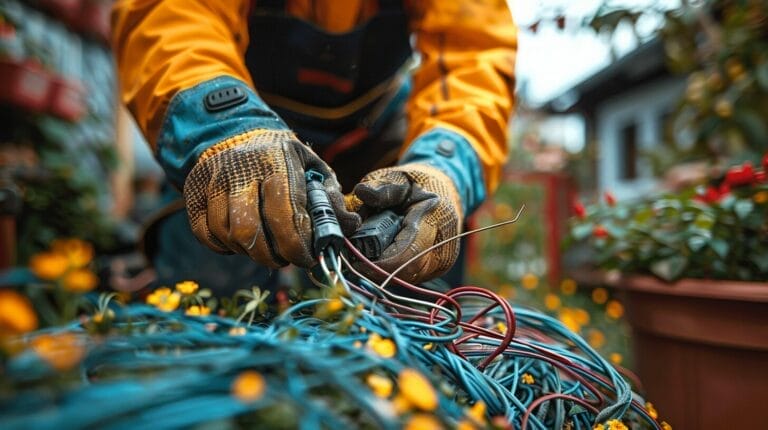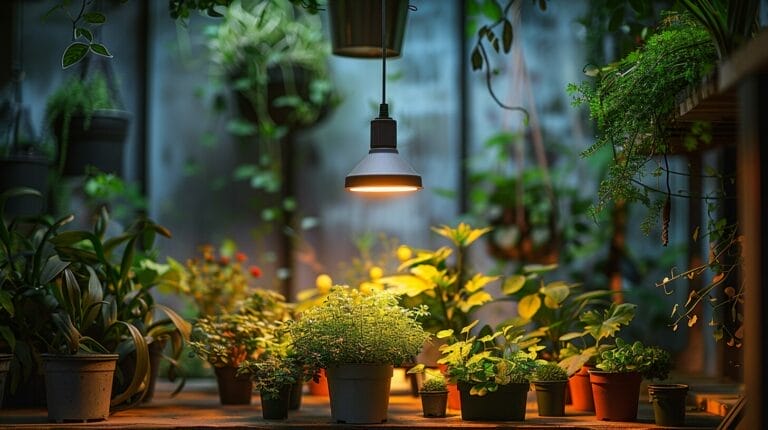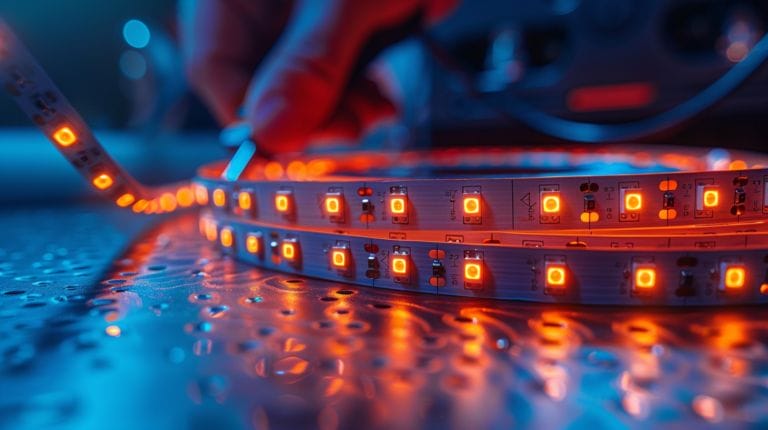Are LED Lights Recyclable? Proper Disposal of Light Bulbs
As we navigate the ever-evolving landscape of sustainability, we often find ourselves asking questions. One such query that floats to the surface is: are LED lights recyclable? Together, let’s illuminate the path towards a greener future by exploring the challenges and solutions in LED light bulb recycling, their role in sustainable practices, and their future prospects.
Key Takeaways
- LED lights have recyclable components such as semiconductor chips, heat sinks, and drivers, indicating that light bulbs can be recycled.
- Local recycling programs and online platforms help find recycling centers for LED bulbs, demonstrating that light bulbs can be recycled.
- Proper handling and storage of used LED bulbs are necessary for safe disposal and transport, especially since they can be reused in new products.
- LED bulb recycling promotes sustainability, reduces environmental impact, and recovers valuable materials.
Understanding the Recyclability of LED Lights

Understanding the recyclability of LED lights is crucial to properly dispose of them and minimize their environmental impact. LED lights, made up of various components such as a semiconductor chip, a heat sink, and a driver, all work together to produce light in a highly efficient manner, showcasing their light-emitting capabilities. Many of these components are recyclable, meaning that LED lights, including old LED components and holiday string lights, can be recycled and repurposed, rather than ending up in landfills.
Compared to traditional light bulbs, LED lights have a lower environmental impact. LED lights don’t contain mercury or any other harmful substances such as heavy metals like lead and arsenic, making them a safer and more environmentally-friendly lighting option. They can be recycled to recover valuable materials like aluminum, copper, plastic, and other components found in light fixtures. By recycling LED lights, we contribute to a more sustainable future and minimize the environmental impact of lighting.
How to Recycle LED Light Bulbs Properly

To properly recycle LED light bulbs, it’s important to follow specific steps to safely store and dispose of used lights, including old LED components and holiday string lights. When it comes to recycling options for LED bulbs, local recycling programs are a great place to start. Many cities and municipalities now offer specialized recycling facilities for light bulbs, including LEDs.
When preparing LED bulbs for recycling, it’s crucial to handle them with care. First, make sure to turn off the power and allow the bulbs to cool down before removal. Next, carefully remove the bulb from its fixture, being mindful of any fragile components. To store used LED bulbs, it’s recommended to place them in a sturdy box or container with protective padding to prevent breakage during transport.
The Challenges and Solutions in LED Light Bulb Recycling

LED light bulb recycling presents several challenges that need to be addressed to increase recycling rates and promote sustainable disposal methods, as well as to salvage components that can be reused in new products. Here are some key challenges in LED light bulb recycling and potential solutions:
- Metal Recovery: Developing efficient methods to recover and reuse the valuable metals like aluminum, copper, and lead that LED bulbs contain is essential in promoting circular economy practices, particularly as it pertains to recycle LED bulbs.
- Mercury Content: While LED bulbs contain significantly less mercury compared to traditional bulbs, proper handling and disposal are still crucial. Establishing guidelines for safe mercury extraction and disposal is necessary to minimize environmental impact and protect public health.
- Hazardous Waste Management: Ensuring that recycling centers have proper protocols and equipment to handle and process hazardous materials is vital to prevent contamination and ensure worker safety, especially for items like circuit boards and Christmas lights that may contain heavy metals like lead and arsenic.
- Recycling Accessibility: Increasing public awareness and providing accessible collection points, such as drop-off locations or curbside pickup, can encourage more people to recycle their bulbs.
- Component Separation: Developing automated systems and technologies that can efficiently sort and separate the components of LED bulbs will streamline the recycling process and improve overall recycling rates.
The Role of LED Light Bulbs in Sustainable Practices

Using LED light bulbs is an effective way to promote sustainable practices and contribute to a greener future. LED bulbs aren’t only energy-efficient, but they also have a longer lifespan compared to traditional bulbs, making the recycling of these light sources even more advantageous. This means less waste and fewer replacements, which ultimately reduces our carbon footprint. LED lights play a crucial role in sustainable development.
According to the Environmental Protection Agency, LED light bulbs are recyclable. When it comes to disposing of them, it’s important to handle them properly and not just throw them in the trash. LED bulbs shouldn’t be thrown in the regular trash, as they contain small amounts of hazardous materials.
Instead, they should be taken to a recycling facility, hardware stores, or a designated recycling bin for proper disposal, ensuring even light bulbs like LED, compact fluorescent lamps, and Christmas lights can be recycled. It’s important to note that not all recycling facilities accept LED lights, so it’s advisable to check with your local recycling center.
How Can I Properly Dispose of LED Christmas Lights?
When it comes to fixing half strand LED lights, it’s important to know that proper disposal is also essential. To dispose of LED Christmas lights, you can check with your local recycling facility for proper disposal options. Some retailers also offer recycling programs for old lights.
The Future of LED Light Bulb Recycling

Innovations in recycling LED light bulbs have paved the way for a more sustainable and efficient approach to disposing of these environmentally-friendly lighting options, reducing e-waste significantly. The future of LED bulb recycling is bright, with efficient recycling processes, supportive policies, and environmental and economic benefits. By embracing these innovations, we can ensure that LED bulbs continue to be a sustainable lighting option that minimizes our impact on the environment.
In conclusion, it’s important to properly dispose of LED light bulbs to contribute to sustainable practices and ensure these recyclable materials support environmental initiatives. As we continue to prioritize sustainability, it’s crucial to play our part in responsibly recycling LED light bulbs for a brighter and greener future, including understanding that various components can be salvaged and reused in new products.
Conclusion
In conclusion, it’s important to properly dispose of LED light bulbs to contribute to sustainable practices, which involves recycling them and not just throwing them in the trash.
While LED lights are recyclable, their recycling process can be challenging due to the presence of hazardous materials, unlike traditional incandescent or even some fluorescent tubes.
However, with advancements in technology and increased awareness, solutions are being developed to overcome these challenges.
As we continue to prioritize sustainability, it’s crucial to play our part in responsibly recycling LED light bulbs for a brighter and greener future.
Frequently Asked Questions
Are LED lights recyclable?
Yes, LED bulbs are recyclable. The process of recycling them is more environmentally friendly than disposing of them in the trash, as it helps conserve earth’s resources.
Can incandescent bulbs also be recycled?
Incandescent bulbs are not as easily recyclable as LEDs or CFLs due to their lack of hazardous materials. However, some recycling programs may accept them, so it’s worth checking recycling in your area.
What should I do with old CFL bulbs?
CFL bulbs contain small amounts of mercury, a heavy metal that is hazardous. Therefore, they should not be thrown in the trash but taken to a recycling drop-off location that accepts CFL bulbs for proper disposal.
How can I find a recycling program for LEDs and CFLs in my area?
Many local municipal waste management departments provide information on LED and CFL recycling. Retailers such as Home Depot, Lowe’s, and IKEA often have recycling drop-off points for old bulbs. Additionally, you can search online for “recycling location” along with your area to find nearby options.
Is it safe to dispose of LED bulbs in regular household trash if I can’t find a recycling program?
While LED bulbs do not contain hazardous materials like CFLs, it’s better for the environment to recycle them if possible. If you must dispose of them, ensure your local guidelines permit it, but always prioritize finding a recycling option.







